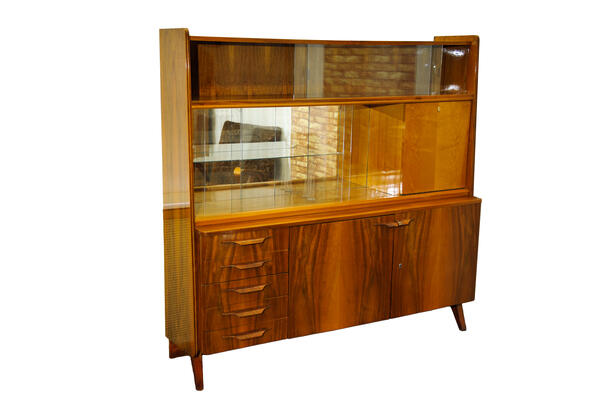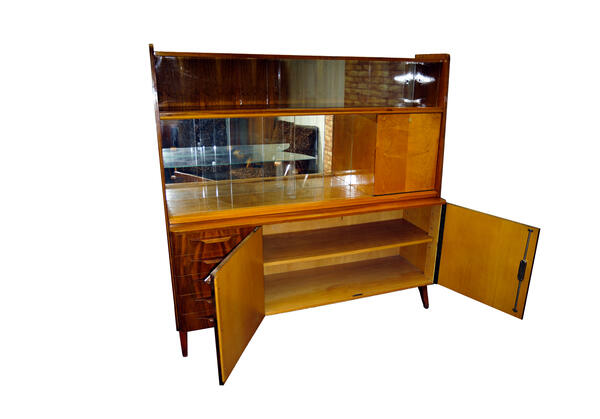Despite the “Iron Curtain” (from 1946-1989, the Iron Curtain was the name of the border between Western Europe and the communist countries of Eastern Europe) that divided the socialist and capitalist countries after the Second World War, Czechoslovakia maintained business and trade relations with Austria. Thanks to this, Czechoslovakia factories could produce furniture under license, which was designed in Vienna by the famous designer and minimalist architect Oswald Gerdtl.
In 1958, young designers from Czechoslovakia Miroslav Navratil, Frantisek Iraq, Jiri Jiroutek, and Antonin Schuman loudly declared themselves at the World Exhibition in Brussels. Their furniture attracted the attention of the press and collected many awards, and the interior style, known in the United States as mid-century modern, is still called “Brusselian” by the Czechs today.
A sideboard is a small, usually two-tier buffet for storing dishes and table linen — tablecloths, linen napkins, towels.
The Czechoslovak sideboard of the Kalashnikov family is made in the style of “minimalism”, which dominated the furniture design of the 1950s and 1960s. This style is characterized by a contrasting combination of straight and rounded corners, shelves that are different in width, as well as not strictly parallel, but slightly converging sides of the panels.
On the upper tier, there is a shelf with two movable glasses on the entire length of the sideboard. A vertical partition is built into the second tier. This partition separates the large section on the left from the closed bar section on the right.
In the right part of the sideboard, there is a rounded glass shelf, which is much shorter than the main section. Therefore, it was possible to put small glasses and coffee service on it, and tall glasses, glass jugs, and voluminous crystal vases — next to it in the lower part.
The first tier has five drawers designed for storing cutlery, napkins, and small serving items. On the right, there is a large compartment with doors and one shelf inside it.
To maintain the symmetry and visual regularity of the appearance of the sideboard, the designer created a bar and a section of drawers of the same size.
Lightwood and mirror-glass inserts distinguish Czechoslovak sideboards from closed massive buffets of the Stalin era, which were made of dark wood. At the bottom of the front part, the sideboard is “raised” on two chiseled legs; it rests on a solid panel at the back. These details give the furniture made at the turn of the 1960s a visual simplicity.
In 1958, young designers from Czechoslovakia Miroslav Navratil, Frantisek Iraq, Jiri Jiroutek, and Antonin Schuman loudly declared themselves at the World Exhibition in Brussels. Their furniture attracted the attention of the press and collected many awards, and the interior style, known in the United States as mid-century modern, is still called “Brusselian” by the Czechs today.
A sideboard is a small, usually two-tier buffet for storing dishes and table linen — tablecloths, linen napkins, towels.
The Czechoslovak sideboard of the Kalashnikov family is made in the style of “minimalism”, which dominated the furniture design of the 1950s and 1960s. This style is characterized by a contrasting combination of straight and rounded corners, shelves that are different in width, as well as not strictly parallel, but slightly converging sides of the panels.
On the upper tier, there is a shelf with two movable glasses on the entire length of the sideboard. A vertical partition is built into the second tier. This partition separates the large section on the left from the closed bar section on the right.
In the right part of the sideboard, there is a rounded glass shelf, which is much shorter than the main section. Therefore, it was possible to put small glasses and coffee service on it, and tall glasses, glass jugs, and voluminous crystal vases — next to it in the lower part.
The first tier has five drawers designed for storing cutlery, napkins, and small serving items. On the right, there is a large compartment with doors and one shelf inside it.
To maintain the symmetry and visual regularity of the appearance of the sideboard, the designer created a bar and a section of drawers of the same size.
Lightwood and mirror-glass inserts distinguish Czechoslovak sideboards from closed massive buffets of the Stalin era, which were made of dark wood. At the bottom of the front part, the sideboard is “raised” on two chiseled legs; it rests on a solid panel at the back. These details give the furniture made at the turn of the 1960s a visual simplicity.




